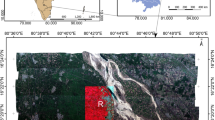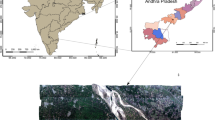Abstract
Hyperspectral data may provide abundant and fine surface spectral details. Their applications can, however, be constrained by their limited bandwidth and small coverage area. As the data having low bandwidth, each band has its significance for studies such as mineral composition, crop monitoring, and identification of materials. But hyperspectral data is expensive, and availability is less compared to multispectral data. Simulation of hyperspectral data with existing Sentinel and AVIRIS data will be an advantage for the analysis. This study concentrates on obtaining similar spectra using distance functions. The Chebyshev distance and spectral angle mapper (SAM) distances are combined to get the advantage of both the distance of vector coordinates and the pattern of the spectra. Each pixel of the test image is verified for the similarity of the whole reference image using distance functions to get similar spectra. These similar spectra are all combined to construct the simulated hyperspectral image. Finally, multispectral image is simulated to hyperspectral imagery. The relevance and novelty of this study is that it uses distance functions to simulate hyperspectral data, and it was discovered that the suggested methodology has good spectral correlation accuracy when compared to the current AVIRIS-NG dataset. The simulated hyperspectral image is validated with the AVIRIS image using normalized cross-correlation to obtain each pixel’s correlation. The normalized cross-correlation of test site-a is obtained as 95.35% and test site-b is 82.28% under 0.9 to 1, and the colour of the false colour composite is identical to the original AVIRIS image.












Similar content being viewed by others
References
Bhattacharya BK, Singh CP (2017) Spectrum of India, ISRO, Ahmedabad, ISBN 9789382760290 Source: https://vedas.sac.gov.in/vedas/downloads/AVIRIS-NG_CTB_SPECTRUM_OF_INDIA.pdf Accessed on 26 Dec 2020)
Chen F, Niu Z, Sun GY, Wang CY, Teng J (2008) Using low-spectral-resolution images to acquire simulated hyperspectral images. Int J Remote Sens 29(10):2963–2980
Crósta AP, Sabine C, Taranik JV (1998) Hydrothermal alteration mapping at Bodie, California, using AVIRIS hyperspectral data. Remote Sens Environ 65(3):309–319
Cuadras CM, Valero S, Cuadras D, Salembier P, Chanussot J (2012) Distance-based measures of association with applications in relating hyperspectral images. Commun Stat-Theor M 41(13–14):2342–2355
Deborah H, Richard N, Hardeberg JY (2015) A comprehensive evaluation of spectral distance functions and metrics for hyperspectral image processing. IEEE J Sel Top Appl 8(6):3224–3234
Demirci S, Erer I, Ersoy O (2015) Weighted Chebyshev distance algorithms for hyperspectral target detection and classification applications. Proc SPIE 9482, Next-Generation Spectrosc Technol VIII 948218:1–17
Hirano A, Madden M, Welch R (2003) Hyperspectral image data for mapping wetland vegetation. Wetlands. 23(2):436–448
Huang Z, Qi C, Qihao C, Liu X, He H (2019) A novel hyperspectral image simulation method based on nonnegative matrix factorization. Remote Sens 11:1–22. https://doi.org/10.3390/rs11202416
Inteti RS, Mandla VR, Peddada JR, Ramesh N (2020) Analysis of rice crop phenology using Sentinel-1 and Sentinel-2 satellite data, lecture notes in. Civ Eng 71:257–266
Krishna G, Sahoo RN, Singh P, Patra H, Bajpai V, Das B, Kumar S, Dhandapani R, Vishwakarma C, Pal M, Chinnusamy V (2019) Application of thermal imaging and hyperspectral remote sensing for crop water deficit stress monitoring. Geocarto Int 36(5):481–498
Kruse FA, Lefkoff AB, Boardman JW, Heidebrecht KB, Shapiro AT, Barloon PJ, H Goetz AF. (1993) The spectral image processing system (SIPS) interactive visualization and analysis of imaging spectrometer data. Remote Sens Environ 44:145–163
Lee KS, Cohen WB, Kennedy RE, Maiersperger TK, Gower ST (2004) Hyperspectral versus multispectral data for estimating leaf area index in four different biomes. Remote Sens Environ 91(3–4):508–520
Rani N, Mandla VR, Singh T (2016) Performance of image classification on hyperspectral imagery for lithological mapping. J Geol Soc India 88(4):440–448
Rani N, Mandla VR, Singh T (2017) Evaluation of atmospheric corrections on hyperspectral data with special reference to mineral mapping. Geosci Front 8(4):797–808
Rani N, Singh T, Mandla VR (2020) Mapping hydrothermal alteration zone through aster data in Gadag Schist Belt of Western Dharwar Craton of Karnataka, India. Environ Earth Sci 79(24):1–19
Siddiqui A, Chauhan P, Kumar V, Jain G, Deshmukh A, Kumar P (2020) Characterization of urban materials in AVIRIS-NG data using a mixture tuned matched filtering (MTMF) approach. Geocarto Int. https://doi.org/10.1080/10106049.2020.1720312
Trahanias PE, Venetsanopoulos AN (1993) Vector directional filter—a new class of multichannel image processing filters. IEEE T Image Process 2(4):528–534
Xuan G, Baoping G (2009) Color image morphology based on distances in the HSI color space. Second ISECS Int Colloq Comput Commun Control Manag CCCM 2009 3:264–267
Yamada T, Ishii N, Nakashima T. (2007). Text classification by combining different distance functions with weights. Seventh ACIS International Conference on Software Engineering, Artificial Intelligence, Networking, and Parallel/Distributed Computing (SNPD'06), 2006, pp. 85-90. https://doi.org/10.1109/SNPD-SAWN.2006.69.
Zhang J, Hu J, Lian J, Fan Z, Ouyang X, Ye W (2016) Seeing the forest from drones: testing the potential of lightweight drones as a tool for long-term forest monitoring. Biol Conserv 198:60–69
Acknowledgements
Authors would like to thank Space Application Centre (SAC) Ahmadabad for the financial support to JRF and data access under the AVIRIS-NG AO project and also thank to Chief Editor and anonymous reviewers for their critical reviewers to improve the manuscript more technically. The first author would like to thank Dr. W.R. Reddy, IAS former Director General, Dr. G. Narendra Kumar, IAS, Director General & Smt. Radhika Rastogi, IAS, Dy. Director General and Head-CGARD of NIRDPR for accepting host institutions and provided computational facilities.
Author information
Authors and Affiliations
Corresponding author
Ethics declarations
Conflict of interest
The authors declare that they have no competing interests.
Additional information
Responsible Editor: Biswajeet Pradhan
Rights and permissions
About this article
Cite this article
Peddinti, V.S.S., Mandla, V.R., Mesapam, S. et al. Simulation of hyperspectral image with existing Sentinel and AVIRIS data using distance functions. Arab J Geosci 14, 1689 (2021). https://doi.org/10.1007/s12517-021-08136-6
Received:
Accepted:
Published:
DOI: https://doi.org/10.1007/s12517-021-08136-6




